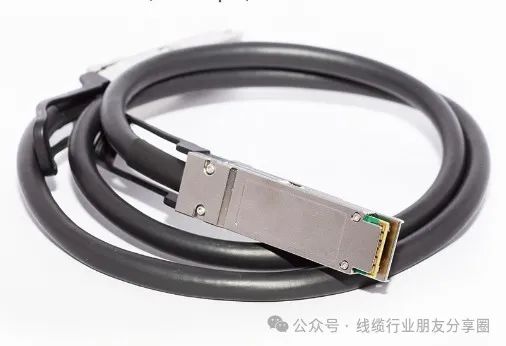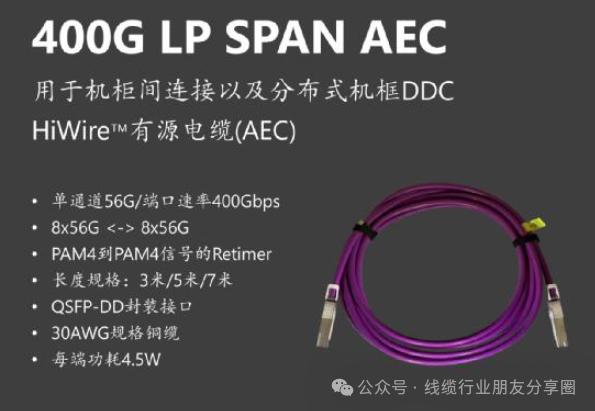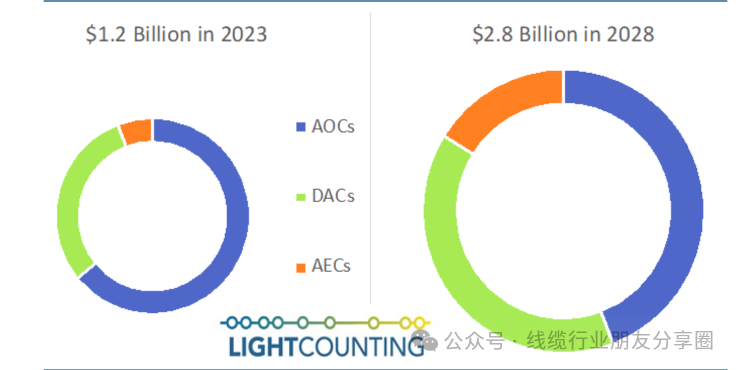The materials shared by this public account are collected and organized from the internet. All text and images are copyrighted by the original authors and represent their personal views, unrelated to this public account. The article is for readers’ learning and exchange purposes only, and please verify the relevant content yourself. If the article content involves infringement, please contact the backend administrator for deletion.Source:Cable Industry Friends Sharing Circle
In today’s fiercely competitive communication industry, everyone hopes to gain a competitive advantage, whether in terms of performance, efficiency, or cost. Although many data centers focus on network adapter and switch configurations, there is an extremely basic yet equally effective way to improve the deployed data center: rethinking interconnect cables. Currently, there are four different types of data transmission cables on the market: DAC (Direct Attach Cable), AOC (Active Optical Cable), AEC (Active Electrical Cable), and ACC (Active Copper Cable). They differ in transmission medium, performance characteristics, and application scenarios. Today, let’s take a look at DAC, AEC, AOC, and ACC, and see who will be the ultimate winner in the field of data communication?

DAC High-Speed Cable
Technical Principles:
DAC high-speed cables (Direct Attach Cable) are generally translated as direct cables or direct copper cables. They are usually purchased in fixed lengths, with fixed connectors on both ends, and the ports cannot be replaced. The module head and copper cable cannot be separated. High-speed cables are increasingly accepted by users for their significant advantages such as high cost-performance ratio, high efficiency, high speed, high integration, and low loss, becoming the preferred solution for high-speed data communication, widely used in storage area networks, data centers, and high-performance computer connections.
Basic Structure of High-Speed Cables
Mainly composed of silver-plated conductors and three types of insulating materials: foamed insulation, Teflon, and PP. They are then shielded by pairs and overall shielding, forming high-speed cables. High-speed cables have excellent attenuation performance, low latency, and anti-interference capabilities, enabling high-frequency broadband transmission, with specifications of 32~24AWG and various structures such as 2P, 4P, 8P, or 16P, applicable in various different scenarios.
Advantages of DAC High-Speed Cables
They have become the preferred solution for users in short-distance application scenarios, widely used in SATA storage devices, RADI system scenarios, core routers, 10G or 40G Ethernet, and other data center interconnect scenarios. In data centers, copper cables are generally used to connect servers and storage area networks. Due to the low price and fast transmission speed of passive copper cables, they have become the best solution for achieving short-distance transmission.
■ High Performance: Suitable for short-distance wiring in data centers, with a wide range of applications and strong integration capabilities.
■ Energy Saving and Environmental Protection: The internal material of high-speed cables is copper core, which has good natural heat dissipation, making it energy-efficient and environmentally friendly.
■ Low Power Consumption: High-speed cables have low power consumption. Passive cables do not require a power source; active cables generally consume about 440mW.
■ Low Cost: The price of copper cables is much lower than that of optical fibers, and using high-speed cables can greatly reduce the overall wiring costs of the data center.

AEC High-Speed Cable
Technical Principles:
Active Electrical Cable (AEC) uses CDR (Clock Data Recovery) and Retimer chip architecture at both ends of the cable to not only amplify and equalize the transmitted signal but also reshape it, thereby extending the transmission distance. It is suitable for applications that require long distances, low power consumption, and compact designs.
Basic Structure of High-Speed Cables
Mainly composed of silver-plated conductors and Teflon insulating materials, AEC cables also use pair shielding and overall shielding to form high-speed cables. They have excellent attenuation performance, low latency, and anti-interference capabilities, enabling high-frequency broadband transmission, with specifications of 28~24AWG and various structures such as 8P and 16P, applicable in various different scenarios.
Advantages of AEC High-Speed Cables
AEC active cables are released by the HiWire Alliance, and the HiWire AEC specification defines the standards for basic electrical and mechanical specifications. AEC active cables support transmission rates of 100G, 200G, and 400G, with packaging types including QSFP56, OSFP, and QSFP-DD, and the longest transmission distance can reach 7 meters. It has forward error correction (FEC) functionality and cable retiming capabilities, ensuring completely equalized signals with ultra-low error rates.
AEC active cables are key enabling technologies for Distributed Chassis (DDC) architecture, overcoming the density, weight, and performance limitations of copper DAC and the cost and availability issues of AOC. Its advantages include low power consumption, low cost, and space-saving, where power consumption is 25% lower than optical devices, costs are 50% lower than optical components, and its size is smaller than DAC, saving up to 70% space compared to DAC while being more reliable than optical.
AEC active cables are mainly used for connections between ToR and servers, distributed chassis, with up to 500 cables wired per rack.
Suitable for applications requiring long-distance transmission, low power consumption, and compact designs, such as interconnect needs in distributed data centers, telecommunications, and enterprise markets.
Power Consumption: Both AOC and AEC have lower power consumption than DAC, helping to reduce overall system energy consumption.
Transmission Distance: The transmission distance of DAC is limited, usually within 5 meters; AEC can extend the transmission distance to longer application scenarios through signal enhancement technology.
Price: AOC is more expensive due to the inclusion of lasers and optical fibers; DAC and AEC are relatively cheap, suitable for large-scale applications.
Size and Weight: AOC and AEC are smaller in size and weight compared to DAC, making them more suitable for space-constrained applications.

AOC High-Speed Cable
Technical Principles:
AOC (Active Optical Cable) refers to communication cables that require external power to convert electrical signals into optical signals or vice versa during communication. The optical transceivers at both ends of the optical cable provide photoelectric conversion and optical transmission functions. It looks similar to copper cables, and AOC uses an optical cable to connect two high-density connectors. AOC contains lasers internally, is more expensive, but offers superior transmission performance.
Basic Structure of High-Speed Cables
Depending on different application scenarios and needs, the detailed structure and components of AOC high-speed cables may vary. For example, some AOC cables may also include auxiliary devices, such as optical amplifiers and optical attenuators, to optimize signal transmission and ensure system stability. In summary, the basic structure of AOC high-speed cables consists of optical fibers, photoelectric converters, and connectors.
Advantages of AOC High-Speed Cables
Firstly, they are much lighter compared to the other two types of high-speed cables; secondly, since optical fibers are a dielectric, they are less susceptible to electromagnetic interference, making them suitable for long-distance, high-reliability applications, such as connections between core switches and long-distance transmission within data centers.
The disadvantages of AOC high-speed cables are also quite obvious.
Compared to high-speed cables, active optical cables are more expensive. The lifespan of AOC optical cables’ lasers is generally 3-5 years, and they are difficult to repair. As a new type of transmission optical cable, AOC requires external power to convert electrical signals into optical signals or vice versa during the communication process. The losses during the conversion process and the heat generated are significant reasons why AOC is difficult to popularize.
However, many in the market believe that AOC optical cables have a longer transmission distance and reduce electromagnetic interference, leading to the misconception that all aspects of the network should adopt this newer technology.

ACC High-Speed Cable
Technical Principles:
ACC (Active Copper Cable): is an active copper cable that incorporates a linear Redriver with certain capabilities at the receiving end (Rx end) of the cable to provide signal equalization and shaping technology. It uses chips to compensate for the high-frequency losses of passive copper DAC, making it more like an active cable that amplifies the intended signal. It extends the transmission distance of traditional copper cables to longer application scenarios. ACC can also be used to connect ToR and servers, providing an economical and efficient way for short links, thus offering greater bandwidth transmission. The transmission distance of ACC can exceed 3m in high-speed transmission, and selecting the correct cable length is crucial as it may be a key variable for overall performance.
ACC supports transmission rates and packaging types such as 10G SFP+, 25G SFP28, 40G QSFP+, 50G QSFP+, 100G QSFP28, 200G QSFP-DD, 400G OSFP, 800G OSFP, 400G QSFP DD, and 800G QSFP-DD.
ACC is mainly used in scenarios requiring signal amplification and reduction, with relatively short transmission distances, and it does not have repair and reconditioning capabilities. Although the market space is small, it still has applications in cost-sensitive scenarios with lower transmission distance requirements.
Summary: DAC, AEC, AOC, and ACC
When selecting data transmission cables, comprehensive considerations should be made based on specific application needs, transmission distances, cost budgets, and space constraints. In the field of data communication, we see the trend of Ethernet applications emerging, and ACC is expected to expand from Infiniband to Ethernet applications. We believe that the upgrade of switch rates will also drive changes in high-speed connection methods in data centers. New products such as AEC and ACC are expected to expand downstream customers. We believe that the emergence of higher-speed switches is likely to drive port rate upgrades, while traditional copper DAC is prone to significant signal loss and attenuation at high speeds. To compensate for signal attenuation, the diameter of DAC needs to be continuously increased. According to Amazon, the outer diameter of a 100G rate DAC supporting 2.5 meters of transmission is 6.7mm, while that of a 400G rate DAC supporting 2.5 meters of transmission reaches 11mm, making it difficult for cloud vendors to arrange data lines. Additionally, the larger outer diameter of DAC also means a larger bending radius, resulting in a larger footprint and usage space for the entire rack. Currently, innovative solutions for high-speed copper connections include active cables like AEC. Compared to DAC, AEC adds chips at both ends of the copper cable for signal recovery, reducing the loss and attenuation of high-speed signals during copper wire transmission. Therefore, AEC has a smaller outer diameter than traditional DAC, occupying less space.In the construction of large-scale AI clusters, we believe that due to the significantly increased interconnection density of AI clusters compared to cloud computing, AEC’s smaller outer diameter is more suitable for wiring in large-scale networks.Moreover, in short-distance transmission, AEC has advantages over optical communication solutions using optical modules and fibers, including low cost, low energy consumption, and low maintenance costs. According to Credo’s calculations, the overall cost of 400G AEC can be reduced by 53% compared to the AOC solution.We believe that as the transmission rates of data center networks continue to increase, DAC will face significant challenges in short-distance transmission, and innovative connection methods such as AEC are expected to replace DAC. According to Lightcounting’s calculations in December 2023, the market for AOC, DAC, and AEC is expected to be $1.2 billion in 2023 and reach $2.8 billion by 2028, with CAGRs of 15%, 25%, and 45% for AOC, DAC, and AEC from 2023 to 2028, respectively.
